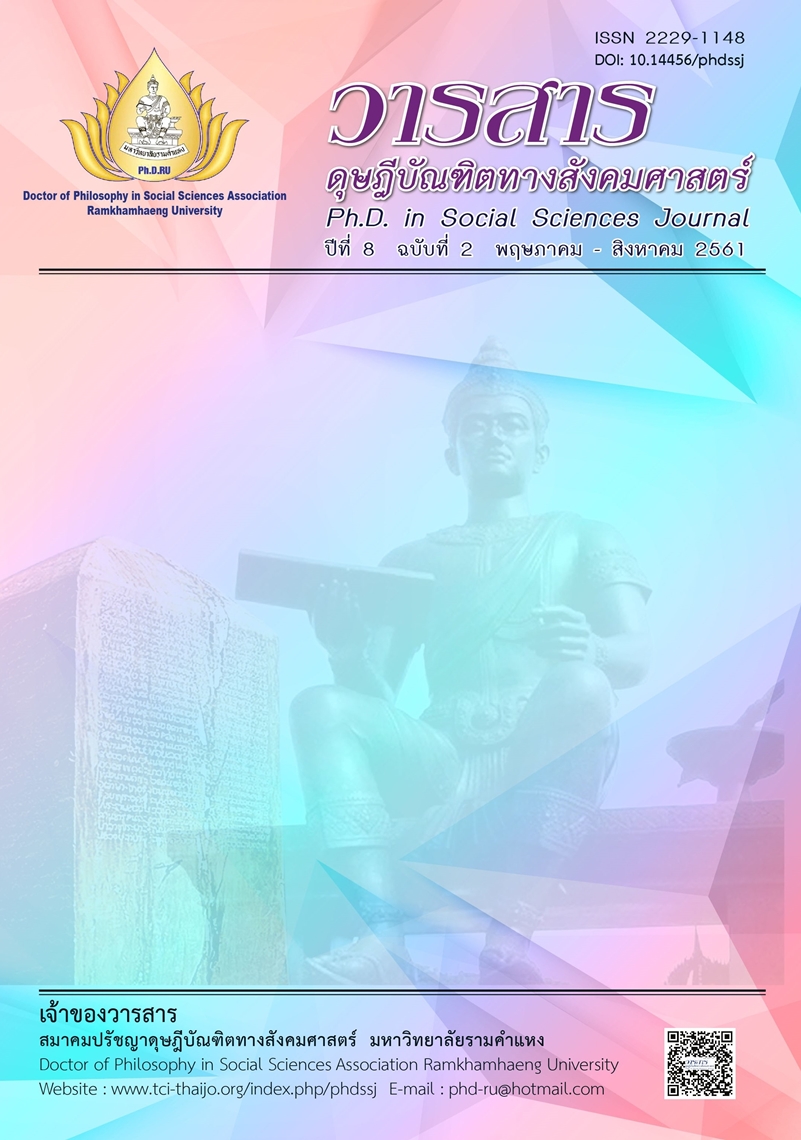PUSH-PULL FACTORS AND BEHAVIOR AFFECTING THAI CONSUMERS’ DECISION TO USE DAY SPA
Main Article Content
Abstract
The purpose of this study were 1) to find the connection between the behavior when using the spa and customer ‘s personal characteristics such as gender, age, level of education, and monthly average income: and 2) to analyze the level of importance of each push and pull factor and market mix in service sector. This study is a quantitative research that uses the questionnaire by focusing on 385 Thai customers who have used the day-spa. The statistic methods that are used in analyzing the data are Descriptive Statistic and Inferential Statistics.
The findings of this study show that there is also a strong relationship between the behavior of Thai customers in choosing the spa service and 2 of the characteristic of each person which are age and job. The respondents give the most importance to the overall push factors by giving the most importance to the push factors and the need for good health and beauty, followed by the need for relief and relaxation. They also give high importance to the overall pull factors such as giving the importance to the safety of the personal and place the most, followed by the image and convenience. In terms of marketing, the overall image of the highest importance level by giving the importance to the marketing mix and the physical environment and presentation the most, followed by the price. The result of this study created the understanding about the internal needs which is the push factors; the motivation from the place itself and the marketing mix of the Thai consumers when choosing day spa and useful to the day spa operators by taking the results to service Thai consumers that have the basis from internal needs and the characteristic of spa.
Article Details
Academic articles, research articles, and book reviews in the Ph.D. in Social Sciences Journal are author’s opinions, and not the publisher’s, and is not the responsibility of the Ph.D. in Social Sciences Journal Philosophy Association, Ramkhamhaeng University. (In the case that research is done on human, the researcher has to be trained in Ethics for Doing Research on Human Training and has to produce the evidence of the training).
References
Bryan, C.-M. C. (2012). Study of the interrelationship of spa guests’ motivation, perceived service quality, value, satisfaction, and behavioral intentions. Oklahoma: Oklahoma State University, Faculty of the Graduate.
Chantaburee, S. (2016). Opportunity and competitiveness of spa and Thai massage businesses in Thailand. Kasem Bundit Journal, 17(2), 49-63. [In Thai]
Chau-in, W., Pintathong, P., & Thitipramote, N. (2012). Study on selecting behavior in spa of Thai and foreigner tourists in Hua Hin, Prachuabkirikhan province. Chiang Rai: Mae Fah Luang University, School of Cosmatic Science. [In Thai]
Christopher, L., & Lauren, W. (2002). Principals of service marketing and management (2nd ed.). Upper Saddle River, NJ: Prentice Hall.
Cochran, W. G. (1993). Sampling techiques. New York: John Wiley & Sons.
Dann, G. (1981). Tourist motivation: An appraisal. Annals of Tourism Research, 8(2), 187-219.
Deniz, K., & Basak D. G. (2014). Measuring spa-goes’ preference: A conjoint analysis approach. International Journal of Hospitality Management, 41, 115-124.
Department of Trade Negotiations. (2011). Services: Spa and health massages. Bangkok: Bureau of Trade in Services and Investment. [In Thai]
Douglas, N. (2001). Travelling for health: Spa and health resorts. In N. Douglas R. & Derrett (Eds.), Special interest tourism (pp.262-268), Milton, Australia: John Wiley & Sons.
Duangchan, D., & Kamkaen, N. (2014). Consumers’ expectations for the health and beauty spa. Bangkok: Suan Dusit Rajabhat University. [In Thai]
Etzel, M. J., Walker, B. J., & Stanton, W. J. (2001). Marketing (12th ed.). Boston: McGraw-Hill.
Erica, T. M., (1996). Salon ovations day spa operations. New York: Milady.
Crompton, J. L., & McKay, S .L. (1997). (1997). Motive of visitors attending festival events. Annals of Tourism Research, 24(2), 425-439.
Hartline, M. D., & Ferrell, O. C. (1996). The management of customer contact service employees. Journal of Marketing, 60(4), 52-70.
Hashemi, S. M., Jusoh, J., Kiumarsi, S., & Mohammadi, S. (2015). Influence factors of spa and wellness tourism on revisit intention: the mediating role of international tourist motivation and tourist satisfaction. International Journal of Research Granthaalayah University Sains Malaysia, 3(7), 1-11.
Jang, S., & Cai, L. A. (2002). Travel motivations and destination: A study of British outbound market. Journal of Travel & Tourism Marketing, 13(3), 111 - 133.
Kotler, P. (2003). Marketing management. Upper Saddle River, NJ: Prentice Hall.
Mak, A. H. N., Wong, K. K. F., & Chang, R. C. Y. (2009). Health or self-indulgence?: The motivations and characteristics of spa-goers. International Journal of Tourism Research, 11, 185-199.
Ministry of Tourism and Sports. (2014). Visitor statistics. Bangkok: Author. [In Thai]
Patikan, S., & Chansom, N. (2012). The decision making to use the spa service of middle age people in Bangkok. Journal of Finance, Investment, Marketing and Business Management, 2(4), 210-228. [In Thai]
Phongvivat, L., & Panadis, S. (2011). Consumer attitude toward spa in Thailand. Vasteras, Sweden: Malardalen University.
Pimolsompong, C. (2007). Planning and development tourism market. Bangkok: Kasetsart University. [In Thai]
Sangpikul, A. (2013). Research methodology for tourism and hospitality. Bangkok: Dhurakij Pundit University Press. [In Thai]
Sareerat, S. (1995). Customer behavior. Bangkok: Thai Wattana Panit. [In Thai]
Sankrusme, S. (2012). Development strategies on taking Thailand’s health promotion related tourism business into the global market. International Business Research, 5(11). [In Thai]
Samerjai, C. (2007). Consumer behavior. Bangkok: SE-ED. [In Thai]
Sirakaya, E., & Woodside, A. G. (2005). Building and testing theories of decision making by travelers. Tourism Management, 26(6), 815-832.
Solomon, M. R. (2013). Consumer behavior: Buying, having and being (10th ed.). Boston: Pearson.
Thammasane, S. (2011). Spa business management in amphoe Muang, Chonburi province. Bangkok: Suan Sunandha Rajabhat University Press. [In Thai]

